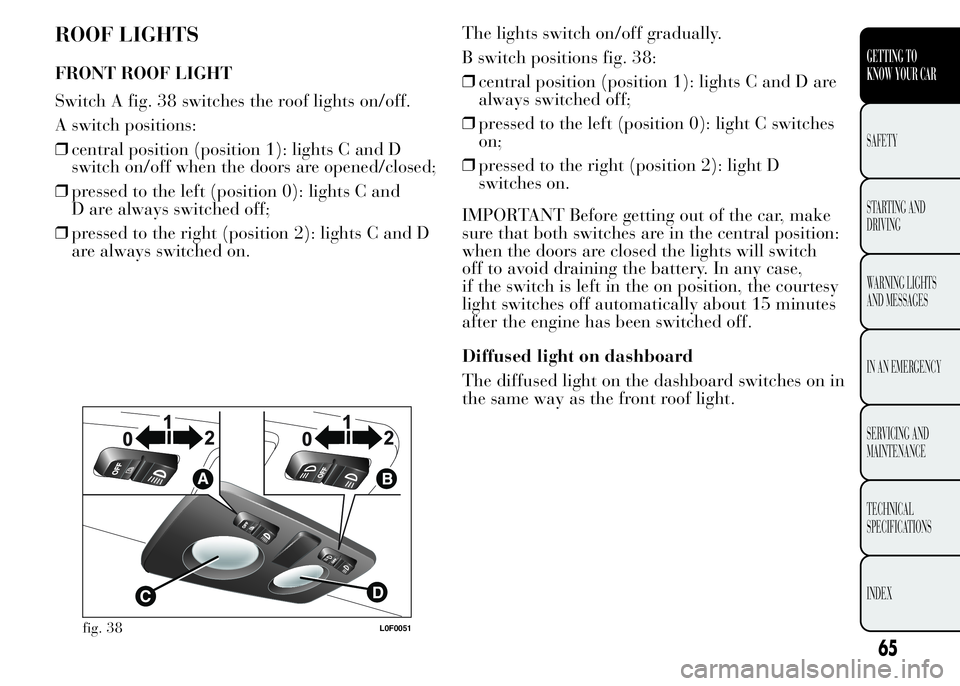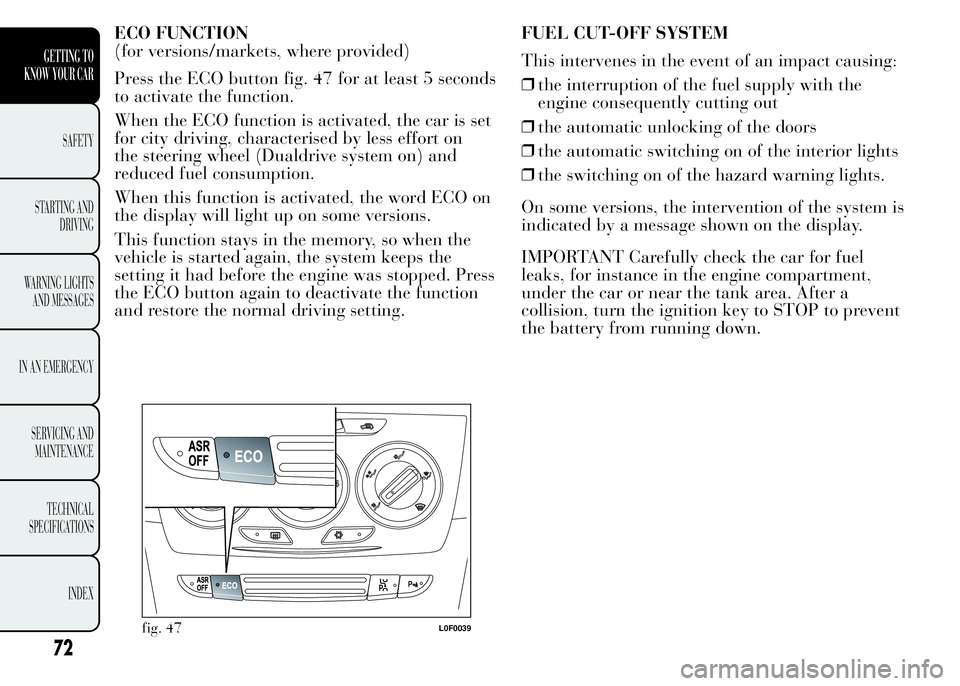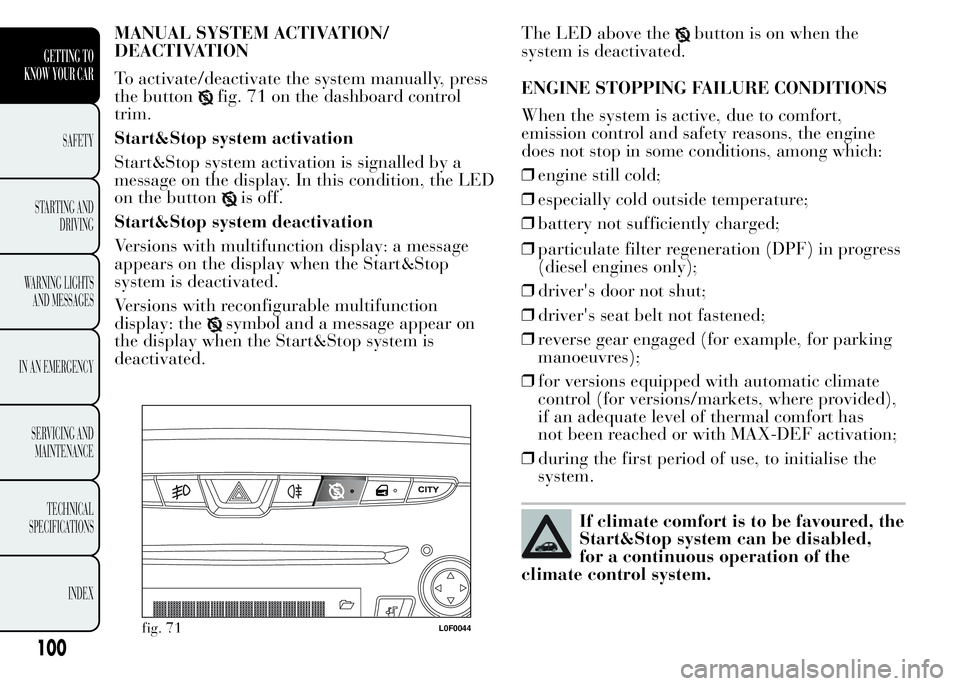engine Lancia Ypsilon 2015 Owner handbook (in English)
[x] Cancel search | Manufacturer: LANCIA, Model Year: 2015, Model line: Ypsilon, Model: Lancia Ypsilon 2015Pages: 315, PDF Size: 10.85 MB
Page 69 of 315

ROOF LIGHTS
FRONT ROOF LIGHT
Switch A fig. 38 switches the roof lights on/off.
A switch positions:
❒central position (position 1): lights C and D
switch on/off when the doors are opened/closed;
❒pressed to the left (position 0): lights C and
D are always switched off;
❒pressed to the right (position 2): lights C and D
are always switched on.The lights switch on/off gradually.
B switch positions fig. 38:
❒central position (position 1): lights C and D are
always switched off;
❒pressed to the left (position 0): light C switches
on;
❒pressed to the right (position 2): light D
switches on.
IMPORTANT Before getting out of the car, make
sure that both switches are in the central position:
when the doors are closed the lights will switch
off to avoid draining the battery. In any case,
if the switch is left in the on position, the courtesy
light switches off automatically about 15 minutes
after the engine has been switched off.
Diffused light on dashboard
The diffused light on the dashboard switches on in
the same way as the front roof light.
fig. 38L0F0051
65
GETTING TO
KNOW YOUR CAR
SAFETY
STARTING AND
DRIVING
WARNING LIGHTS
AND MESSAGES
IN AN EMERGENCY
SERVICING AND
MAINTENANCE
TECHNICAL
SPECIFICATIONS
INDEX
Page 70 of 315

ROOF LIGHT TIMING
On certain versions, to facilitate getting into/out of
the car, especially at night or in poorly-lit areas,
two timed modes have been provided.
Timing when getting into the car
The roof lights switch on according to the
following modes:
❒for about 10 seconds when the doors are
unlocked;
❒for about 3 minutes when one of the doors is
opened;
❒for about 10 seconds when the doors are closed.
The timed period is interrupted when the ignition
key is turned to MAR-ON.
The lights switch off in three ways:
❒when all doors are closed, the 3-minute timer
will stop and a 10-second one will start. This
timer will stop when the key is turned to
MAR-ON;
❒when doors are locked (either with remote
control or with key on driver side door), the roof
light switches off;
❒the courtesy lights are switched off in any case
after 15 minutes to preserve battery chargeTiming when getting out of the car
After removing the key from the ignition switch,
the roof lights switch on as follows:
❒if the ignition key is removed within 3 minutes
from the engine stopping, the roof lights switch
on for 10 seconds;
❒for about 3 minutes when one of the doors is
opened;
❒for about 10 seconds when one of the doors is
closed.
The timing stops automatically when the doors are
locked.
66
GETTING TO
KNOW YOUR CAR
SAFETY
STARTING AND
DRIVING
WARNING LIGHTS
AND MESSAGES
IN AN EMERGENCY
SERVICING AND
MAINTENANCE
TECHNICAL
SPECIFICATIONS
INDEX
.
Page 76 of 315

ECO FUNCTION
(for versions/markets, where provided)
Press the ECO button fig. 47 for at least 5 seconds
to activate the function.
When the ECO function is activated, the car is set
for city driving, characterised by less effort on
the steering wheel (Dualdrive system on) and
reduced fuel consumption.
When this function is activated, the word ECO on
the display will light up on some versions.
This function stays in the memory, so when the
vehicle is started again, the system keeps the
setting it had before the engine was stopped. Press
the ECO button again to deactivate the function
and restore the normal driving setting.FUEL CUT-OFF SYSTEM
This intervenes in the event of an impact causing:
❒the interruption of the fuel supply with the
engine consequently cutting out
❒the automatic unlocking of the doors
❒the automatic switching on of the interior lights
❒the switching on of the hazard warning lights.
On some versions, the intervention of the system is
indicated by a message shown on the display.
IMPORTANT Carefully check the car for fuel
leaks, for instance in the engine compartment,
under the car or near the tank area. After a
collision, turn the ignition key to STOP to prevent
the battery from running down.
fig. 47L0F0039
72
GETTING TO
KNOW YOUR CAR
SAFETY
STARTING AND
DRIVING
WARNING LIGHTS
AND MESSAGES
IN AN EMERGENCY
SERVICING AND
MAINTENANCE
TECHNICAL
SPECIFICATIONS
INDEX
Page 96 of 315

CLOSING
Proceed as follows:
❒keep the bonnet raised with one hand and
remove rod C fig. 67 from housing D with the
other, inverting the opening motion, then fit
it back into its catch;
❒lower the bonnet to approximately 20
centimetres from the engine compartment and
let it drop. Make sure that the bonnet is
completely closed and not only fastened by the
safety catch by trying to open it. If it is not
perfectly closed, do not try to press the bonnet
lid down but open it and repeat the procedure.
IMPORTANT Always check that the bonnet is
closed correctly to avoid it opening while the car is
travelling.
WARNING
Perform these operations only when
the car is stationary.
ROOF RACK/SKI RACK
The attachments A fig. 68are located in the areas
illustrated in the figure and can only be accessed
with the doors open. The Lineaccessori Lancia
includes a dedicated roof rack/ski rack for this
car.
WARNING
After travelling for a short distance,
check that the fixing screws for the
attachments are correctly tightened.
fig. 68L0F0098
92
GETTING TO
KNOW YOUR CAR
SAFETY
STARTING AND
DRIVING
WARNING LIGHTS
AND MESSAGES
IN AN EMERGENCY
SERVICING AND
MAINTENANCE
TECHNICAL
SPECIFICATIONS
INDEX
Page 101 of 315

SYSTEM INTERVENTION
It is signalled by the flashing of theESCwarning
light on the instrument panel, to inform the driver
that the car is in critical stability and grip
conditions.
SYSTEM ACTIVATION
The ESC system switches on automatically when
the engine is started and cannot be switched off.
HILL HOLDER SYSTEM
This system is an integral part of the ESC system
and facilitates starting on slopes.
It is activated automatically in the following
instances:
❒uphill: car stationary on a road with a gradient
higher than 5%, engine running, brake pressed
and gearbox in neutral or gear (other than
reverse) engaged;
❒downhill: car stationary on a road with a
gradient higher than 5%, engine running, brake
pressed and reverse gear engaged.
When setting off, the ESC system control unit
maintains braking pressure on the wheels until the
torque required for starting is reach or, in any
case, for a maximum of 2 seconds so that the right
foot can be moved easily from the brake pedal to
the accelerator pedal.When 2 seconds have elapsed, without any
departure having taken place, the system is
automatically deactivated, gradually releasing the
braking pressure. During this release stage, a
typical mechanical brake release noise can
be heard, indicating that the car is about to move.
IMPORTANT The Hill Holder system is not a
parking brake, therefore do not leave the vehicle
without activating the handbrake, switching
off the engine and engaging first gear.
ASR SYSTEM (AntiSlip Regulation)
It is an integral part of the ESC system. It
automatically operates in the event of one or both
drive wheels slipping, loss of grip on wet roads
(aquaplaning) and acceleration on slippery, snowy
or icy roads, etc…
Depending on the slipping conditions, two
different control systems are activated:
❒if the slipping involves both drive wheels, the
ASR intervenes reducing the power transmitted
by the engine;
❒if the slipping only involves one of the drive
wheels, it intervenes automatically braking
the wheel that is slipping.
97
GETTING TO
KNOW YOUR CAR
SAFETY
STARTING AND
DRIVING
WARNING LIGHTS
AND MESSAGES
IN AN EMERGENCY
SERVICING AND
MAINTENANCE
TECHNICAL
SPECIFICATIONS
INDEX
Page 102 of 315

Activation/deactivation of the ASR system
The ASR system activates automatically each time
the engine is started.
Whilst driving, the ASR can be deactivated and
subsequently activated again by pressing the ASR
OFF button fig. 70.
On some versions, the intervention of the system is
indicated by a message shown on the display.
When the system is not active, the LED on the
button ASR OFF turns on and, on some versions,
a message appears on the display.
When the ASR is deactivated whilst driving, the
next time the car is started the ASR is
automatically activated.
When travelling on snowy roads with snow chains,
it may be helpful to turn the ASR off: in fact, in
these conditions, slipping of the drive wheels when
moving off makes it possible to obtain better
traction.WARNING
For the ESC and ASR systems to
function correctly, all four tyres must,
above all, be the type, brand and size
prescribed, of the same brand and type, and
must be in excellent condition.
WARNING
The ESC functions even when the
space-saver wheel is being used.
Always remember that the space-saver
wheel, being smaller than the original
wheel, provides less grip.
WARNING
Do not take unnecessary risks, even if
your vehicle is fitted with the ESC
and ASR systems. Your driving style must
always be suited to the road conditions,
visibility and traffic. The driver is always
responsible for road safety.
fig. 70L0F0040
98
GETTING TO
KNOW YOUR CAR
SAFETY
STARTING AND
DRIVING
WARNING LIGHTS
AND MESSAGES
IN AN EMERGENCY
SERVICING AND
MAINTENANCE
TECHNICAL
SPECIFICATIONS
INDEX
Page 103 of 315

BRAKE ASSIST
The system, which cannot be turned off,
recognises emergency braking (on the basis of the
brake pedal operating speed) and speeding up
the response of the braking system. The Brake
Assist device is deactivated if there is a ESC
system failure.
MSR SYSTEM
(Motor Schleppmoment Regelung)
This system is an integral part of the ABS, that
intervenes, if there is sudden downshifting,
restoring torque to the engine, thereby preventing
excessive drive at the drive wheels which,
especially in poor grip conditions, could lead to a
loss in stability of the car.START&STOP SYSTEM
INTRODUCTION
The Start&Stop system automatically stops the
engine each time the car is stationary and starts it
again when the driver wants to move off. In this
way, the car efficiency is increased, by reducing
consumption, dangerous gas emissions and noise
pollution.
OPERATING MODES
Engine stopping mode
With the car stopped, the engine stops with
gearbox in neutral and clutch pedal released.
NoteThe engine can only be stopped
automatically after driving at a speed of more
than about 10 km/h, to prevent the engine from
being repeatedly stopped when driving at walking
pace.
The
symbol appears on the display when the
engine stops.
Restarting the engine
Press the clutch pedal to restart the engine.
99
GETTING TO
KNOW YOUR CAR
SAFETY
STARTING AND
DRIVING
WARNING LIGHTS
AND MESSAGES
IN AN EMERGENCY
SERVICING AND
MAINTENANCE
TECHNICAL
SPECIFICATIONS
INDEX
Page 104 of 315

MANUAL SYSTEM ACTIVATION/
DEACTIVATION
To activate/deactivate the system manually, press
the button
fig. 71 on the dashboard control
trim.
Start&Stop system activation
Start&Stop system activation is signalled by a
message on the display. In this condition, the LED
on the button
is off.
Start&Stop system deactivation
Versions with multifunction display: a message
appears on the display when the Start&Stop
system is deactivated.
Versions with reconfigurable multifunction
display: the
symbol and a message appear on
the display when the Start&Stop system is
deactivated.The LED above the
button is on when the
system is deactivated.
ENGINE STOPPING FAILURE CONDITIONS
When the system is active, due to comfort,
emission control and safety reasons, the engine
does not stop in some conditions, among which:
❒engine still cold;
❒especially cold outside temperature;
❒battery not sufficiently charged;
❒particulate filter regeneration (DPF) in progress
(diesel engines only);
❒driver's door not shut;
❒driver's seat belt not fastened;
❒reverse gear engaged (for example, for parking
manoeuvres);
❒for versions equipped with automatic climate
control (for versions/markets, where provided),
if an adequate level of thermal comfort has
not been reached or with MAX-DEF activation;
❒during the first period of use, to initialise the
system.
If climate comfort is to be favoured, the
Start&Stop system can be disabled,
for a continuous operation of the
climate control system.
fig. 71L0F0044
100
GETTING TO
KNOW YOUR CAR
SAFETY
STARTING AND
DRIVING
WARNING LIGHTS
AND MESSAGES
IN AN EMERGENCY
SERVICING AND
MAINTENANCE
TECHNICAL
SPECIFICATIONS
INDEX
Page 105 of 315

ENGINE RESTARTING CONDITIONS
For reasons of comfort, to limit harmful emissions
and for safety purposes, the engine can restart
automatically without any action by the driver if
certain conditions are met, including:
❒battery not sufficiently charged;
❒reduced braking system vacuum (e.g. if the
brake pedal is pressed repeatedly);
❒car moving (e.g. when driving on roads with a
gradient);
❒engine stopping by Start&Stop system for over
3 minutes;
❒for versions equipped with automatic climate
control (for versions/markets where provided),
to enable suitable thermal comfort or with
MAX-DEF activation.
With gear engaged, automatic engine restarting is
possible only by fully depressing the clutch pedal.
The driver is informed by the displaying of a
message on the display and - for versions/markets,
where provided - by the flashing of the symbol
.Notes
If the clutch is not pressed, 3 minutes after the
engine stops, the engine can be restarted only
using the ignition key.
In cases when the engine stops and this is not
desired, due for example to the clutch pedal being
released sharply with a gear engaged, if the
Start&Stop system is activated, the engine can be
restarted by fully depressing the clutch pedal or
by placing the gear lever in neutral.
SAFETY FUNCTIONS
When the engine is stopped by the Start&Stop
system, if the driver releases his/her seat belt and
opens the driver's or passenger's door, the engine
can be restarted only using the ignition key.
The driver is informed by a buzzer and by the
flashing of the symbol
on the display; on some
versions, a message is displayed as well.
101
GETTING TO
KNOW YOUR CAR
SAFETY
STARTING AND
DRIVING
WARNING LIGHTS
AND MESSAGES
IN AN EMERGENCY
SERVICING AND
MAINTENANCE
TECHNICAL
SPECIFICATIONS
INDEX
Page 106 of 315

"ENERGY SAVING" FUNCTION
(for versions/markets, where provided)
If, following automatic engine restarting, the
driver does not carry out any action on the car for
over 3 minutes, the Start&Stop system stops the
engine once and for all, to prevent fuel
consumption. In these cases, the engine can be
restarted only using the ignition key.
NoteIn any case, it is possible to keep the engine
running by deactivating the Start&Stop system.
IRREGULAR OPERATION
In the event of malfunction, the Start&Stop
system is deactivated.
Versions with multifunction display: the
warning light on the instrument panel switches
on and a message appears on the display in the
event of Start&Stop system failure.
Versions with reconfigurable multifunction
display: the
icon switches on and a message
appears on the display in the event of Start&Stop
system failure.
In the event of a Start&Stop system failure,
contact a Lancia Dealership.CAR INACTIVITY
In the event of car inactivity, special attention
must be paid due to the disconnection of the
battery power supply.
Proceed as follows: detach the connector A fig. 72
(by pressing button B) from sensor C for
monitoring the status of the battery installed on
the negative battery pole D. This sensor should
never be disconnected from the pole except if the
battery is replaced.
WARNING
When replacing the battery, always
contact a Lancia Dealership. Replace
the battery with one of the same type
(HEAVY DUTY) and with the same
specifications.
fig. 72L0F0083
102
GETTING TO
KNOW YOUR CAR
SAFETY
STARTING AND
DRIVING
WARNING LIGHTS
AND MESSAGES
IN AN EMERGENCY
SERVICING AND
MAINTENANCE
TECHNICAL
SPECIFICATIONS
INDEX